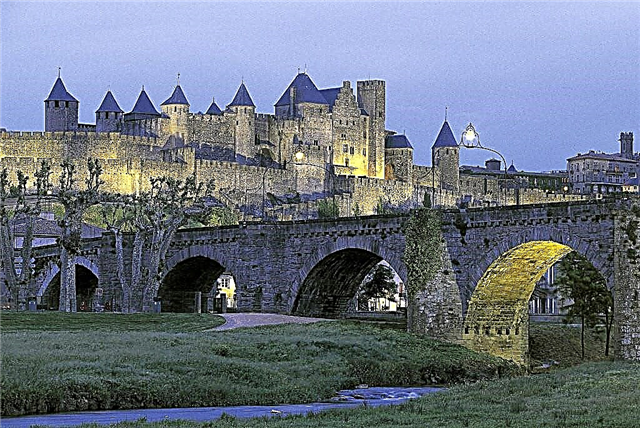Grand Duke Andrei Bogolyubsky, having declared Vladimir the capital of the Vladimir-Suzdal principality, began to strengthen his capital city. In 1158 he surrounded the city with a rampart, and in 1164 he built five entrance gates. Only the Golden Gate has survived to this day, serving as the front entrance to the richest princely boyar part of the city.
History and description
The oak doors of the gate, which are not there now, were bound with sheets of gilded copper, shining brightly in the sun, therefore the gate was called Golden... The gate was built by Vladimir architects. This is evidenced by two princely signs carved on one of the stones in the southern niche of the Golden Gate.

Bird's-eye view of the golden gate
There is a legend that when the work was coming to an end and the scaffolding was dismantled, the arches of the gate suddenly collapsed and buried 12 people. None of the eyewitnesses doubted that people were crushed to death under the weight of stones, but Andrei Bogolyubsky ordered to bring the miraculous icon of the Mother of God and turned to the heavenly patroness with a prayer for the unfortunate.

General view of the Golden Gate
They cleared the blockage and found the people lying under it safe and sound. In honor of the miracle that happened, Andrei Bogolyubsky ordered to build a tiny white-stone chapel of the Position of the Robe of the Mother of God over the Golden Gate. The Golden Gate served a variety of functions. Firstly, they served as the main entrance to the city - through them the prince's squads, returning from the battlefield, rode into Vladimir.

View of the Golden Gate from Kozlov Val
A white-stone triumphal arch, reaching a height of 14 meters, a grand passage tower and massive oak gates hanging on forged hinges, gave the structure a majestic appearance that corresponded to its purpose. Secondly, the Golden Gate, along with the non-preserved Copper, Irinin, Silver and Volga gates, constituted a single complex of defensive fortifications of the city of Vladimir.

View of the Golden Gate from the Trinity Church
The gates were adjacent to an arched lintel, on the top of which a wooden flooring was arranged, which served as a battle platform. From this site, the defenders of the city fired at the enemy. From the flooring, only large square nests have survived, intended for powerful wooden beams.
The ascent to the site was carried out by a stone staircase, arranged in the thickness of the southern wall. Among other things, The Golden Gate served as a decorative function, serving as a symbol of princely power and wealth.

The graceful gate chapel crowning the gate blessed everyone who came to Vladimir in peace. In 1810, the Church of the Robe was completely rebuilt, and today it houses exposition of the military history museum... Under the vaults of the chapel, there is a large diorama depicting the assault of Vladimir by the troops of Khan Batu on February 7, 1238. Thanks to light and music effects and soundtrack with the announcer's text, the picture recreates in detail the capture of the city by the Mongol-Tatars.

View of the Golden Gate from st. Noble
Lost Relic of the Golden Gate
In 1238, hordes of Mongol-Tatars, having devastated many Russian cities, approached Vladimir. The townspeople prepared for the defense and hid all the valuable relics in case the enemy did break through. The idea was a success: the gilded doors of the Golden Gate have not been found so far and are officially included in the UNESCO registers as masterpieces lost by mankind. In the 1970s, the Council of Ministers of the Soviet Union received an unexpected proposal from Tokyo. The Japanese corporation promised to clear the bottom of the Klyazma River and even expand its channel.

View of the Golden Gate from the Kozlov Val
For their work, the Japanese did not demand either Sakhalin or the Kuril Islands and did not even ask for money. As payment, they wanted to take everything that they would find at the bottom of the Klyazma. This proposal was never accepted by the Soviet authorities, but it made us think about the question: "What values did the Japanese want to find in the river in order to recoup their costs?" Perhaps the Japanese were looking for gilded plates that once adorned the gates of the Golden Gate. Rescuing precious doors from Khan Batu, the townspeople drowned them in Klyazma.

View of the Golden Gate from Nikitskaya Street
Some researchers believe that this hypothesis is implausible, since enemy scouts were vigilantly watching the city and its environs, so the inhabitants did not have time to take out the gold from Vladimir or drown it in the waters of the Klyazma. According to an alternative version, the relic is hidden in one of the city walls or rests in an underground cache under the foundation. One way or another, the location of the gilded plates still remains a mystery.
Attraction rating:











